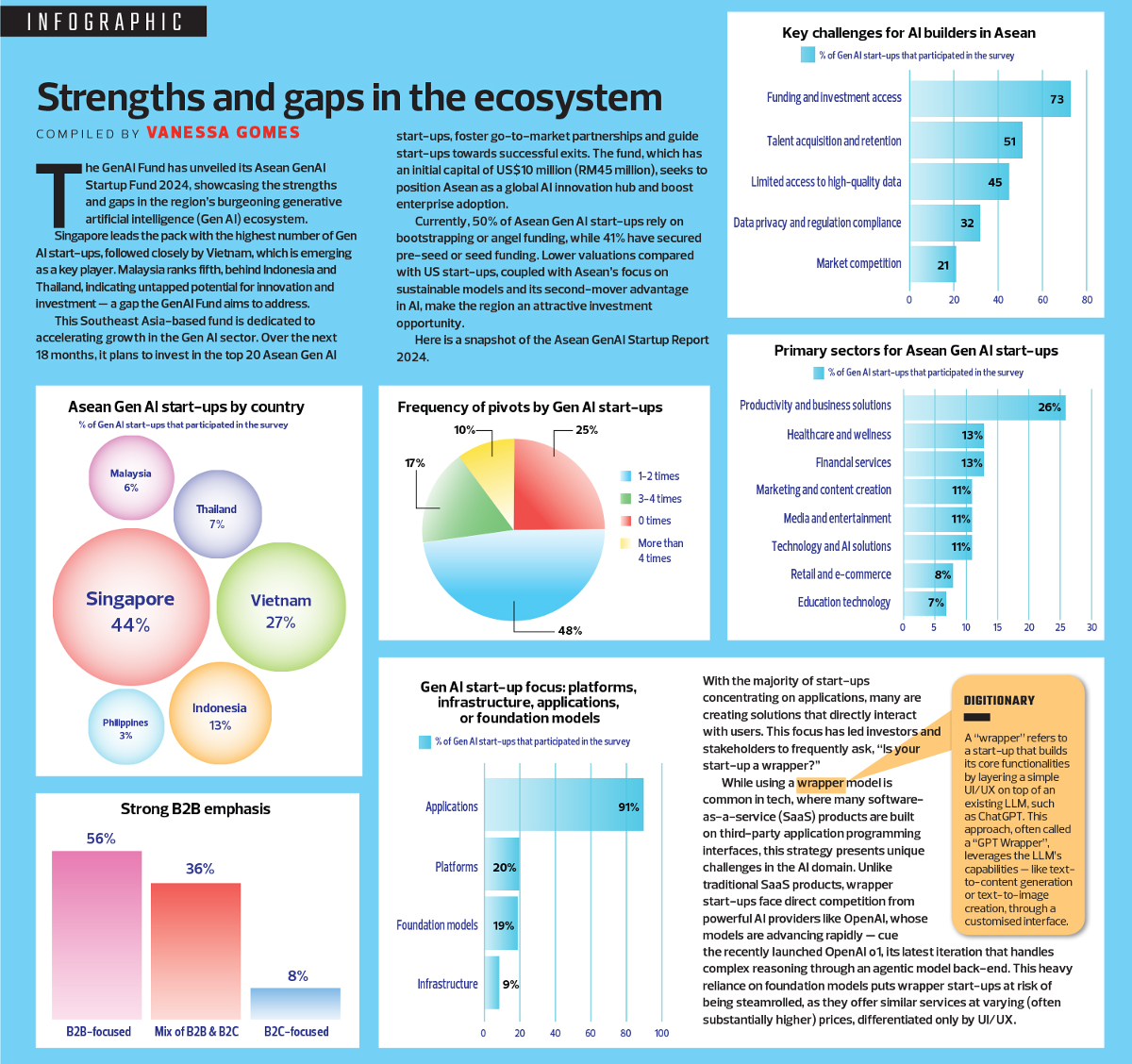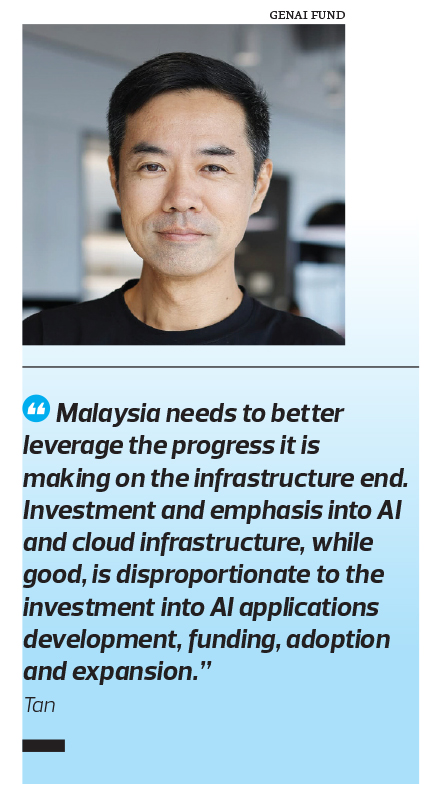
This article first appeared in Digital Edge, The Edge Malaysia Weekly on December 30, 2024 - January 12, 2025
Generative artificial intelligence (Gen AI) start-ups have been mushrooming in the region, and so has access to funding. However, it remains unclear how geopolitical tensions and the new administration in the US will affect Malaysia and the Gen AI space.
On the limited partner (LP) investment end for venture capital (VC), a buoyant US public market, followed by the continued rise in gold, crypto and the US dollar, could potentially shift some private investment dollars away from certain VC allocations, depending on who the LPs consist of.
What’s clear is that we live in technologically exciting yet uncertain times, says Denning Tan, partner at GenAI Fund, a Southeast Asia-based fund focused on Gen AI.
In the Asean GenAI Startup Report 2024, published by GenAI Fund, Malaysia ranked fifth in the region after Singapore, Vietnam, Indonesia and Thailand. According to Tan, this ranking reflects the current count of Gen AI and AI start-ups in each country. He stressed, however, that given the early stage of mainstream Gen AI adoption, these rankings are fluid and likely to shift as the ecosystem evolves.
“In an AI world where technology is progressing so rapidly, and where AI itself will soon be prompted to create other start-ups, the notion of ‘start-up count’ may become a lot less important.
“What will matter more will be how these start-ups succeed as a business, the impact they make regionally and globally, investments, their exits by mergers and acquisitions (M&A) and initial public offerings (IPOs), and how they ethically improve society. These metrics will be far more critical and Malaysia is well-positioned to start taking a lead in these alongside the growth in AI infrastructure.”
Malaysia’s fifth placing is due to other key countries possessing some natural advantages and also the country being behind in terms of start-up funding generally over the last few years, which affects its base of developers, founders, sentiment and start-up ecosystem.
The good news, says Tan, is that Malaysia has done exceptionally well in attracting infrastructure investment for building hyperscalers, graphics processing units (GPUs), and AI infrastructure and the semiconductor industry. This sets the stage for the Gen AI software application and foundation model end in Malaysia to take off.
“We are also seeing Malaysian conglomerates, enterprises and small and medium enterprises (SMEs) taking a stronger interest in advancing AI and Gen AI, such as YTL Corp Bhd (KL:YTL), Gamuda Bhd (KL:GAMUDA) and Sunway Bhd (KL:SUNWAY), to name a few.”
For investors, there is a risk of investing without sufficient understanding of the underlying technology involved and how easily the start-up itself can be made redundant. There is also the risk of not being able to attract enough strong talent as the start-up grows.
Given the need for business-to-business (B2B) Gen AI start-ups to gain traction and achieve product-market fit with local enterprises and businesses — especially those that target niche solutions, as is the case with many Gen AI start-ups — they must also quickly generate business beyond Malaysia to achieve a large enough total addressable market, given that niche use cases have a smaller total addressable market.
“There is a very real risk and possibility that the start-up solution is only suitable for Malaysia and unable to scale,” Tan says.
Nevertheless, he believes that Malaysia will experience a good transition year as efforts to drive Gen AI and AI development kick into higher gear. Enterprises will be more primed for Gen AI adoption and funding is expected to rise markedly percentage-wise in Asean, given its relatively lower base.
“We expect there to be a few local IPOs (initial public offerings) involving tech companies active in AI over the next 18 months. However, it’s unclear if infrastructure investments in the space will continue to gather the same pace, as there are rumblings of falling margins from GPU rentals and services from projected oversupply of compute power and increasing commoditisation.
“In addition, there are question marks over the continued exponential growth of LLM (large language model) advancement, with some slowdowns and bottlenecks being seen among leaders in the space.”
Right now, Malaysia needs to significantly ramp up enterprise and SME innovation and adoption of Gen AI and AI. There are many ways to do this, says Tan, and some large businesses have made notable efforts, but it requires a great deal more urgency and supporting policies.
To further accelerate Gen AI adoption, GenAI Fund has started running GenAI Open Innovation Days, matching curated Gen AI start-ups with strong enterprise use cases regionally. It expects to run at least 10 such events in Malaysia and regionally in 2025.
“Malaysia needs to better leverage the progress it is making on the infrastructure end. Investment and emphasis into AI and cloud infrastructure, while good, is disproportionate to the investment into AI application development, funding, adoption and expansion,” he says.
“Given the relative strength with its neighbours and also increasing attraction to large developed nations, more can be done on true collaboration that targets specific metrics and KPIs (key performance indicators), not just infrastructure investments. Deliberate and deep, mutual collaboration among key partners is key.”
Broader Asean region leads in other areas
Singapore’s top ranking mirrors its ranking pre-Gen AI, which makes it a strong base for start-ups to build Gen AI applications. It also benefits from being a strong financial, governance, tech and structural base for start-ups to be located regardless of where the products were built or where they largely operate from.
The availability of strong talent in Singapore is also evident among developers, founders, operators and Singapore start-ups by virtue of its smaller market and regional and global targets from day one.
“Singapore will continue to be strong and indeed, from when the report was launched to date, has gone on to further consolidate its pole position from 44% of total Asean start-up count to 49%,” Tan tells Digital Edge.
A surprise to many — but not the GenAI Fund team — is Vietnam’s second-place ranking. This success stems from its robust developer base and thriving builder culture. Tan explains that it has taken to Gen AI like a “duck to water”, making development seem almost effortless.
“We are seeing more interesting applications and use cases coming out from Vietnam, especially on agentic models, with quicker builds, experimentation, iterations and pivots versus other countries at this stage,” he says.
“Vietnam is shaping up to be the epicentre of Gen AI, especially from a development and build perspective. However, it trails some other countries when it comes to successful go-to-market and commercialisation, which is an area where we are starting to see more progress.”
Indonesia in third place is another surprise, given its large populace, says Tan, but it is only a matter of time before it accelerates. Meanwhile, Thailand benefits from having an ecosystem heavily influenced by corporate investment into start-ups, which aligns well with the business models and solutions mostly built by Gen AI start-ups today, which are largely B2B.
Funding gap not apparent but more investments expected
VC investment into Gen AI in Asean as a whole is still in the early stages, partly as a result of a lack of familiarity with the technology, and a lack of understanding over how meaningful it is for business and how disruptive it is. Tan explains that VC firms are apprehensive about investing in start-ups that could potentially be made redundant by the rate of big tech innovation, and advancements in LLMs like OpenAI.
The funding gap is not so apparent at this point and clearer indications will definitely be seen next year as more investments are made, and some earlier start-ups progress into Series A rounds and beyond, drawing a bigger amount of funding.
“Based on what we see, I can say that promising Malaysian Gen AI start-ups (some in stealth) will be making their mark soon in the region. Malaysia is taking many positive steps to bolster the Gen AI ecosystem — education, innovation, adoption, funding, infrastructure and policy.
“We are generally optimistic but only time and the right execution will tell.”
Currently, the funding emphasis is on B2B Gen AI start-ups and Tan anticipates that the winners will be start-ups that can leverage Gen AI the quickest to develop large (and painfully needed) use cases, possess the team capable of delivering enterprise customer needs, can achieve product-market fit and contextualise solutions quickly.
Most important is the knowledge to go-to-market and sell well — locally and regionally for a start — with products that appeal on a global scale.
“At the end of the day, the ability to sell well into businesses with a strong product is key, and traction from those with a good team will strongly encourage funding. Hype alone will be difficult.”
GenAI Fund currently invests in pre-Series A start-ups — mainly pre-seed and seed. For pre-seed stage investments, the emphasis is on the founder and his team, the solution or use case and the fund’s confidence in the team to build and execute. Aside from investment, GenAI Fund also has two other mandates: to drive go-to-market deliberately and prepare start-ups for the option of exits.
The fund looks for clarity of pain points, approach and well-articulated build scope and use of funds, clear understanding of how Gen AI and AI will be used in the build and user journey, defensibility and track record. New founders with novel ideas are also encouraged.
For seed-stage investments, it would be ideal if an initial product or minimum viable product has been built, with strong demos that can stand the rigour of the fund’s tech partners. The fund looks for product traction (proofs of concept, early sales, customer feedback, acceptance into relevant accelerators, among other things) that can be used to sufficiently analyse and validate the company, with early signs of product-market fit and proving the potential total addressable market.
It also looks at the stage of go-to-market, the ability to sell, especially for B2B start-ups, and how forward-thinking the start-up is in terms of leveraging Gen AI and AI in its continued build.
As the space is evolving quickly, Tan foresees M&A rising, given that many Gen AI start-ups are building solutions for enterprises at a time when enterprises are becoming increasingly hungry for Gen AI and AI adoption.
“We are also anticipating a growing interest by pre-IPO and IPO companies to acquire Gen AI and AI start-ups to accelerate their own AI agenda,” he says.
“We do anticipate start-ups getting ‘listed’ indirectly through listed entity acquisitions and exiting through direct listings in the future, primarily on local and regional stock exchanges.”

Save by subscribing to us for your print and/or digital copy.
P/S: The Edge is also available on Apple's App Store and Android's Google Play.
- Trump exempts phones, computers, chips from ‘reciprocal’ tariffs
- Aaron-Wooi Yik trounce defending champions, edge closer to first BAC title
- Fed’s deepest tariff fear is a price shock that won’t fade away
- Russia's Lavrov praises Trump's understanding of Ukraine conflict
- Amanah confident in helping to secure 5 voting districts in Ayer Kuning state by-election
- Aaron-Wooi Yik trounce defending champions, edge closer to first BAC title
- Amanah confident in helping to secure 5 voting districts in Ayer Kuning state by-election
- Russia's Lavrov praises Trump's understanding of Ukraine conflict
- Trump exempts phones, computers, chips from ‘reciprocal’ tariffs
- Fed’s deepest tariff fear is a price shock that won’t fade away

